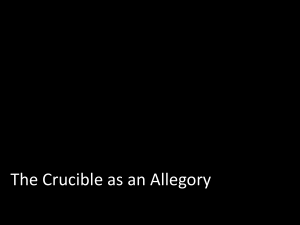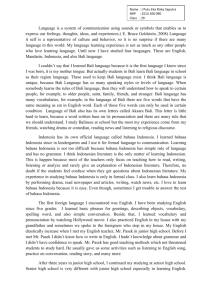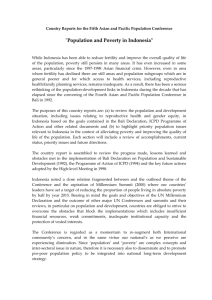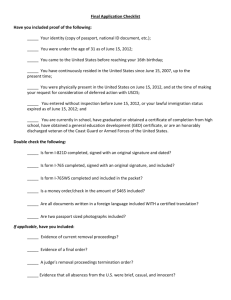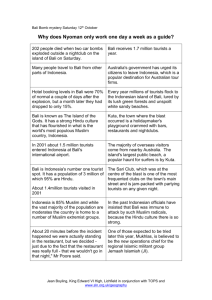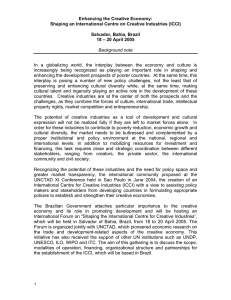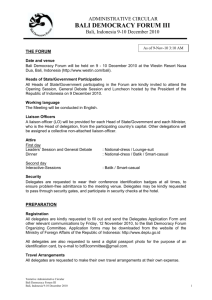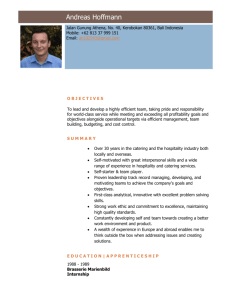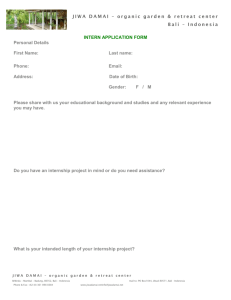Second Author
advertisement
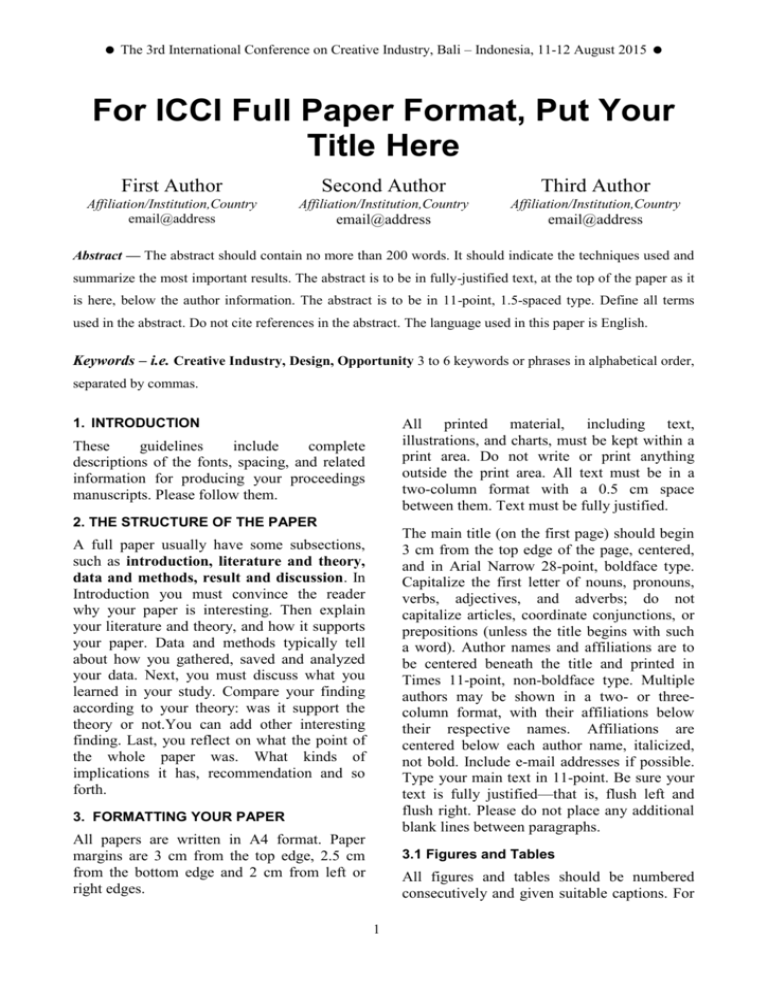
The 3rd International Conference on Creative Industry, Bali – Indonesia, 11-12 August 2015 For ICCI Full Paper Format, Put Your Title Here First Author Second Author Third Author Affiliation/Institution,Country email@address Affiliation/Institution,Country Affiliation/Institution,Country email@address email@address Abstract — The abstract should contain no more than 200 words. It should indicate the techniques used and summarize the most important results. The abstract is to be in fully-justified text, at the top of the paper as it is here, below the author information. The abstract is to be in 11-point, 1.5-spaced type. Define all terms used in the abstract. Do not cite references in the abstract. The language used in this paper is English. Keywords – i.e. Creative Industry, Design, Opportunity 3 to 6 keywords or phrases in alphabetical order, separated by commas. 1. INTRODUCTION All printed material, including text, illustrations, and charts, must be kept within a print area. Do not write or print anything outside the print area. All text must be in a two-column format with a 0.5 cm space between them. Text must be fully justified. These guidelines include complete descriptions of the fonts, spacing, and related information for producing your proceedings manuscripts. Please follow them. 2. THE STRUCTURE OF THE PAPER The main title (on the first page) should begin 3 cm from the top edge of the page, centered, and in Arial Narrow 28-point, boldface type. Capitalize the first letter of nouns, pronouns, verbs, adjectives, and adverbs; do not capitalize articles, coordinate conjunctions, or prepositions (unless the title begins with such a word). Author names and affiliations are to be centered beneath the title and printed in Times 11-point, non-boldface type. Multiple authors may be shown in a two- or threecolumn format, with their affiliations below their respective names. Affiliations are centered below each author name, italicized, not bold. Include e-mail addresses if possible. Type your main text in 11-point. Be sure your text is fully justified—that is, flush left and flush right. Please do not place any additional blank lines between paragraphs. A full paper usually have some subsections, such as introduction, literature and theory, data and methods, result and discussion. In Introduction you must convince the reader why your paper is interesting. Then explain your literature and theory, and how it supports your paper. Data and methods typically tell about how you gathered, saved and analyzed your data. Next, you must discuss what you learned in your study. Compare your finding according to your theory: was it support the theory or not.You can add other interesting finding. Last, you reflect on what the point of the whole paper was. What kinds of implications it has, recommendation and so forth. 3. FORMATTING YOUR PAPER All papers are written in A4 format. Paper margins are 3 cm from the top edge, 2.5 cm from the bottom edge and 2 cm from left or right edges. 3.1 Figures and Tables All figures and tables should be numbered consecutively and given suitable captions. For 1 The 3rd International Conference on Creative Industry, Bali – Indonesia, 11-12 August 2015 each figure, use one single image instead of multiple images. the document are manipulated in MS Word. To minimize this problem, use an image editing tool to resize the image at the appropriate printing resolution (usually 300 dpi), and then insert the image into Word using Insert | Picture | From File. Place figures and tables at the top or bottom of the appropriate column or columns, on the same page as the relevant text (see Figure 1). Please note that the words “Figure” and “Table” should be spelled out (e.g., “Figure” rather than “Fig.”) wherever they occur. 4. REFERENCING Make sure that the format of the reference list is in accordance with the APA styles. The reference list should be arranged in alphabetic order. For papers from conference proceedings, include the title of the paper and an abbreviated name of the conference (e.g., for ICCI 2011 proceedings, use Proc. ICCI 2011). Do not include the location of the conference or the exact date; do include the page numbers if available. See the examples of citations at the end of this document. Figure 1. Figure captions should be placed below the table. Your references should be published materials accessible to the public. Internal technical reports may be cited only if they are easily accessible (i.e., you provide the address for obtaining the report within your citation) and may be obtained by any reader for a nominal fee. Proprietary information may not be cited. Private communications should be acknowledged in the main text, not referenced (e.g., “[Jordan, personal communication]”). All figures should also include alt text for improved accessibility. In Word, right click the figure, and select Format Picture | Alt Text). Papers and notes may use color figures, which are included in the page limit; the figures must be usable when printed in black and white in the proceedings. Please note that the references at the end of this document are in the preferred referencing style. Give all authors’ names; do not use “et al.” unless there are six authors or more. Use a space after authors' initials. Papers that have not been published should be cited as “unpublished”. Papers that have been submitted for publication should be cited as “submitted for publication”. Papers that have been accepted for publication, but not yet specified for an issue should be cited as “to be published”. Please give affiliations and addresses for private communications. Table 1. Table captions should be placed above the table. Theme of ICCI Year Place Sustainability 2011 Sanur, Bali Indonesia Empowering Design Quality in The 2013 Creative Industry Era Surabaya, East Java Indonesia Empowering Design Quality in The 2015 Creative Industry Era Denpasar, Bali - Indonesia 4.1 Abbreviations and Acronyms 3.2 Inserting Images Define abbreviations and acronyms the first time they are used in the text, even after they have already been defined in the abstract. Occasionally MS Word generates larger-thannecessary PDF files when images inserted into 2 The 3rd International Conference on Creative Industry, Bali – Indonesia, 11-12 August 2015 Abbreviations that incorporate periods should not have spaces: write “C.N.R.S.,” not “C. N. R. S.” Do not use abbreviations in the title unless they are unavoidable. English translation of a book Baudrillard, J. (2006). The system of objects (J. Benedict, Trans.). New York: Verso. (Original work published 1968) 4.2 Quotation Article or chapter in an edited book For material quoted directly from references that is fewer than 40 words, incorporate the quotation into the text and enclose it with double quotation marks, such as: Schon (1983) points out, “the idea of reflective practise leads to a vision of professionals as agents of society’s reflective conversation with its situation” (p. 353). If there are 40 or more words in the quotation, present it as an isolated paragraph, omit the quotation marks, and write it as an example below: Schon (1983) said that: Schifferstein, H. N. J., Mugge, R., & Hekkert, P. (2004). Designing consumer-product attachment. In D. McDonagh, P. Hekkert, J. Van Erp, & D. Gyi (Eds.), Design and emotion: The experience of everyday things (pp. 327-331). London: Taylor & Francis. Article in a published proceedings Khalid, H. M. (2001). Can customer needs express affective design? In M. G. Helander, H. M. Khalid, & T. M. Po (Eds.), Proceedings of Affective Human Factors Design (pp. 190-198). London: Asean Academic Press. … the idea of reflective practise ... professionals as agents of society’s reflective conversation with its situation, agents who engage in cooperative inquiry within a framework of institutionalized contention (p. 353 or pp. 353-35x) Article in an electronic proceedings Chen, C.-w., You, M., Liu, H., & Lin, H. (2006). A usability evaluation of web map interface. In E. Koningsveld (Ed.), Proceedings of the 16th World Congress of the International Ergonomics Association [CD ROM]. New York: Elsevier Science. ACKNOWLEDGMENT Acknowledgement of people who contributed to the work and financial supports from government agencies or other sponsors is listed before the References (Endnote) section. The authors’ information should be kept anonymous for the double-blind review process. Article from an online magazine or news Wallis, C. (2005, January 09). The new science of happiness. Time Magazine. Retrieved July 15, 2006, from http://www.time.com/time/magazine/article/0,9171 ,1015902,00.html. Unpublished master’s thesis or doctoral dissertation McNeil, P. (1993). Designing women: Gender, modernism and interior decoration in Sydney, c. 1920–1940. Unpublished master’s thesis, Australian National University, Canberra, Australia. REFERENCES Journal article Desmet, P. M. A., & Hekkert, P. (2007). Framework of product experience. International Journal of Design, 1(1), 57-66. Journal article, Internet-only journal Report Wu, J. T., & Liu, I. M. (1987). Exploring the phonetic and semantic features of Chinese words (Tech. Rep. No. NSC75 0310 H002-024). Taiwan National Science Council. Bergen, D. (2002, Spring). The role of pretend play in children's cognitive development. Early Childhood Research & Practice, 4(1). Retrieved February 1, 2004, from http://ecrp.uiuc.edu/v4n1/bergen.html. Web document from a university program or department Web site Book Schon, D. A. (1983). The Reflective Practitioner (9th ed.). London: Ashgate. 3 The 3rd International Conference on Creative Industry, Bali – Indonesia, 11-12 August 2015 Degelman, D., & Harris, M. L. (2000). APA style essentials. Retrieved May 18, 2000, from Vanguard University, Department of Psychology Web site: http://www.vanguard.edu/faculty/ddegelman/index .aspx?doc_id=796. Stand-alone Web document (no date) Nielsen, M. E. (n.d.). Notable people in psychology of religion. Retrieved August 3, 2001, from http://www.psywww.com/psyrelig/psyrelpr.htm. Stand-alone Web document (no author, no date) Gender and society. (n.d.). Retrieved December 3, 2001, from http://www.trinity.edu/~mkearl/gender.html. Journal article from database Hien, D., & Honeyman, T. (2000). A closer look at the drug abuse-maternal aggression link. Journal of Interpersonal Violence, 15(5), 503-522. Retrieved May 20, 2000, from ProQuest database. Abstract from secondary database Garrity, K., & Degelman, D. (1990). Effect of server introduction on restaurant tipping. Journal of Applied Social Psychology, 20(1), 168-172. Abstract retrieved July 23, 2001, from PsycINFO database. 4


